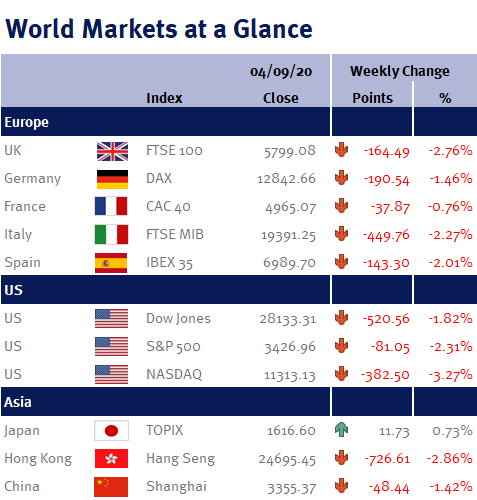With the kids now back in school, it hasn’t exactly been the summer we all expected at the beginning of the year! However, while there have been lots of cancelled holidays and no relaxing on Mediterranean beaches, it hasn’t stopped the positive economic data readings.
Therefore it was disappointing to see the media making a lot of this week’s equity market declines. For example, yesterday (Thursday 3 September 2020) saw the FTSE-100 reverse an early gain of nearly 1% to close down just over 1.50%, an intra-day move of nearly 145 points! While over on Wall Street, the Dow Jones closed down over 800 points, or 2.78% and the S&P 500 fell 3.51% – and then fell a further 0.56% and 0.81% respectively today (Friday 4 September 2020).
While we don’t want to sound blasé, as we fully appreciate that this equity market volatility will be unpleasant and unnerving, it is very important to put everything into perspective. For example, while a two-day fall of 4.30% (or 154 points) in the S&P 500 is big, it only took the index back to levels seen just two weeks ago! Furthermore, in June 2020 when the S&P 500 (and global equity markets) declined by this sort of magnitude it proved to be just a temporary setback, as losses were recouped within a month.
We believe that this fall was simply some froth coming off equities after their recent gains, rather than the start of a deeper equity market correction – and as such it is important to maintain a long-term perspective and resist the urge for any knee-jerk reactions as there will always be periods of market volatility.
Yes, there are risks ahead, notably the upcoming US Presidential election; the continuing political stalemate in Washington over a new US fiscal stimulus package to help those Americans that have been hit hard by the coronavirus outbreak; the winding down of the UK’s support measures; and of course Brexit – but none of these risks are new.
In fact, fundamentally, nothing changed in the past two days: central bank policies remain highly accommodative and economic data continues to improve, which clearly indicates to us that an economic recovery remains in place, be it ‘V-shaped’, or at worst, a ‘Nike Swoosh’ shaped recovery (i.e. still a strong recovery, just slightly slower than a ‘V-shaped’ recovery).
For example, the Fed underscored its supportive longer-term monetary policy last week (please see here) by changing its inflation target from 2% to one that averages 2%. This means that the Fed will allow inflation to run above 2% following periods below 2%.
Consequently, this confirms to us that US interest rates will be low for the foreseeable future: the Fed’s favoured inflation measure, the Core PCE reading, has averaged just 1.60% over the past 10 years and is currently just 1.3% – so being very overly simplistic to illustrate the point, the Fed could allow US inflation to run at 2.4% for the next 10 years (in order to average 2% over the whole 20 year period) before considering raising interest rates. Obviously getting US inflation up to 2.4% will be difficult given all the stimulus over the past 10 years hasn’t generated the inflation that was expected – and then getting it to stay there for 10 years will be nigh on impossible. And importantly, low interest rates for the foreseeable future provides a very positive backdrop for global equity markets.
Furthermore, the global economy continues to show signs of improvement with plenty of encouraging data this week.
China’s services PMI rose to 55.2 in August from 54.2 in July (50 is the line separating expansion and contraction, so this reading shows that the Chinese economy continues to strengthen – and this is very positive as China is ahead of most countries on the path to a full economic rebound).
Elsewhere, the US ISM manufacturing survey came in at 56.0 for August, compared to 54.2 in July and expectations of 54.8, while new orders soared to 67.6, from 61.5 – its highest reading since January 2004.
Additionally, today’s US employment data showed 1.37m jobs were added during August, while the average number of hours worked increased to 34.6 from 34.5 (which together suggests to us that we will see a significant rebound in US GDP during Q3). However, the real highlight for us was the US unemployment rate, which dropped to 8.4% from 10.2%.
Looking ahead to this coming week, while US equity markets are closed on Monday (7 September 2020) for Labor Day, it won’t be a quiet week. In addition to the US weekly jobless claims data (Thursday 10 September 2020), we have the European Central Bank (ECB) monetary policy meeting (also on Thursday) – and this has become even more important than usual after the ECB’s chief economist, Philip Lane, said he was concerned about the strength of the euro (and any hints of a looser monetary policy and/or dovish message would be an additional positive for equity markets).
Elsewhere we have UK GDP for July; UK industrial and manufacturing production; Chinese trade balance; and US and Chinese CPI inflation.
Investment Management Team


